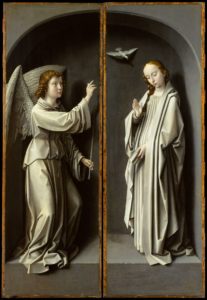All I have to say is that there is a reason the MET is widely known and regarded, and well you can tell. In other words, it is packed especially Friday afternoons. But, despite the foot traffic, the museum in itself is both externally and internally beautiful and eloquent. The entrance to the museum almost reminds me of European style architecture, and the large stairs are inviting and enticing, almost asking for someone to enter this historically charged, beautiful world. Also, other than the fact that it is difficult to navigate through the museum, you can literally and figuratively get lost in it. Between trying to find renaissance and baroque artwork, added to the many distractions (in other words collections) it is impossible to only spend an hour in the MET. It’s basically a sin not to spend more than two hours admiring.
The two artworks I chose to represent either Renaissance or Baroque art are Gerard David’s, Archangel Gabriel; The Virgin Annunciate (Renaissance) and Christian Wilhelm Ernst Dietrich’s The Adoration of the Shepherds (Baroque).
Other than the dates, the Renaissance piece is much more simplistic and technical. It is very simpler to ancient classical Roman and Greek artwork. It focuses much more on the mimetic representation and anatomical correctness. In other words, it is much more linear and lacks motion, along with emotion. This transition from medieval, abstracted artwork is notable because of the application of heavenly (outer world) figures, such as saints can now be found on the Earth, and is applicable to the working man.
The Baroque piece is much more dramatized and can almost be mistaken as chaotic. In other words, it is much more life like or what modernly we call an off-guarded moment. This style is most simpler to the shift of classical artwork towards Hellenistic artwork. Rather than static, baroque artwork is much more dynamic. It depicts both emotion and motion.




